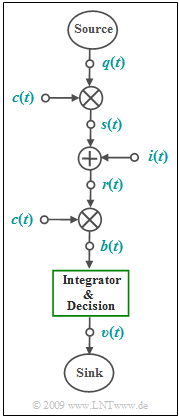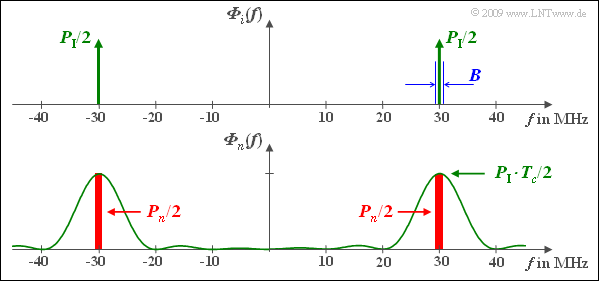Exercise 5.2: Band Spreading and Narrowband Interferer
From LNTwww
A spread spectrum system is considered according to the given diagram in the equivalent low-pass range:
- Let the digital signal q(t) possess the power-spectral density Φq(f), which is to be approximated as rectangular with bandwidth B=1/T=100 kHz (a rather unrealistic assumption):
- Φq(f)={Φ00forotherwise.|f|<B/2,
- Thus, in the low-pass range, the bandwidth (only the components at positive frequencies) is equal to B/2 and the bandwidth in the band-pass range is B.
- The band spreading is done by multiplication with the PN sequence c(t) of the chip duration Tc=T/100
("PN" stands for "pseudo-noise"). - To simplify matters, the following applies to the auto-correlation function:
- φc(τ)={1−|τ|/Tc0forotherwise.−Tc≤τ≤Tc,
- At the receiver, the same spreading sequence c(t) is again added phase-synchronously.
- The interference signal i(t) is to be neglected for the time being.
- In subtask (4) i(t) denotes a narrowband interferer at carrier frequency fT=30 MHz=fI with power PI.
- The influence of the (always present) AWGN noise n(t) is not considered in this exercise.
Note:
- This exercise belongs to the chapter Direct-Sequence Spread Spectrum Modulation.
Questions
Solution
(1) The power-spectral density (PDS) Φc(f) is the Fourier transform of the triangular ACF, which can be represented with rectangles of width Tc as follows:
- φc(τ)=1Tc⋅rect(τTc)⋆rect(τTc).
- From this follows Φc(f)=1/Tc⋅[Tc⋅sinc(fTc)]⋅[Tc⋅sinc(fTc)]=Tc⋅sinc2(fTc) with maximum value
- Φc(f=0)=Tc=T100=1100⋅B=1100⋅1051/s=10−71/Hz=0.1⋅10−61/Hz_.
(2) By definition, with T_c = T/100 = 0.1\ \rm µ s:
- B_c= \frac{1}{T_c} \cdot \hspace{-0.03cm} \int_{-\infty }^{+\infty} \hspace{-0.03cm} {\it \Phi}_{c}(f)\hspace{0.1cm} {\rm d}f = \hspace{-0.03cm} \int_{-\infty }^{+\infty} \hspace{-0.03cm} {\rm sinc}^2 \left(f T_c \right )\hspace{0.1cm} {\rm d}f
- \Rightarrow \hspace{0.3cm} B_c= \frac{1}{T_c}\hspace{0.15cm}\underline {= 10\,{\rm MHz}} \hspace{0.05cm}
The graph illustrates,
- that B_c is given by the first zero of the \rm sinc^2 function in the equivalent low-pass range,
- but at the same time also gives the equivalent (equal area) bandwidth in the band-pass region.
(3) Solutions 2 and 5 are correct:
- The PDS {\it \Phi}_s(f) results from the convolution of {\it \Phi}_q(f) and {\it \Phi}_c(f). This actually gives B_s = B_c + B for the bandwidth of the transmitted signal.
- Since the spreading signal c(t) ∈ \{+1, –1\} multiplied by itself always gives the value 1, naturally b(t) ≡ q(t) and consequently B_b = B.
- Obviously, the bandwidth B_b of the band compressed signal is not equal to 2B_c + B, although the convolution {\it \Phi}_s(f) ∗ {\it \Phi}_c(f) suggests this.
- This is due to the fact that the power density spectra must not be convolved, but the spectral functions (amplitude spectra) S(f) and C(f) must be assumed, taking into account the phase relations.
- Only then can the PDS B(f) be determined from {\it \Phi}_b(f). Clearly, the following is also true: C(f) ∗ C(f) = δ(f).
(4) Only the first solution is correct. The solution shall be clarified by the diagram at the end of the page:
- In the upper diagram the PDS {\it \Phi}_i(f) of the narrowband interferer is approximated by two Dirac delta functions at ±f_{\rm T} with weights P_{\rm I}/2. Also plotted is the bandwidth B = 0.1 \ \rm MHz (not quite true to scale).
- The receiver-side multiplication with c(t) – actually with the function of the band compression, at least with respect to the useful part of r(t) – causes a band spreading with respect to the interference signal i(t). Without considering the useful signal, b(t) = n(t) = i(t) · c(t). It follows:
- {\it \Phi}_{n}(f) = {\it \Phi}_{i}(f) \star {\it \Phi}_{c}(f) = \frac{P_{\rm I}\cdot T_c}{2}\cdot {\rm sinc}^2 \left( (f - f_{\rm T}) \cdot T_c \right )+ \frac{P_{\rm I}\cdot T_c}{2}\cdot {\rm sinc}^2 \left( (f + f_{\rm T}) \cdot T_c \right ) \hspace{0.05cm}.
- Note that n(t) is used here only as an abbreviation and does not denote AWGN noise.
- In a narrow range around the carrier frequency f_{\rm T} = 30 \ \rm MHz, the PDS {\it \Phi}_n(f) is almost constant. Thus, the interference power after band spreading is:
- P_{n} = P_{\rm I} \cdot T_c \cdot B = P_{\rm I}\cdot \frac{B}{B_c} = \frac{P_{\rm I}}{J}\hspace{0.05cm}.
- This means: The interference power is reduced by the factor J = T/T_c by band spreading, which is why J is often called "spreading gain".
- However, such a "spreading gain" is only given for a narrowband interferer.


